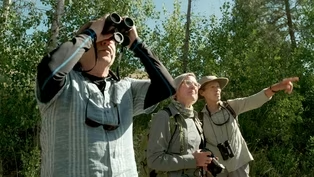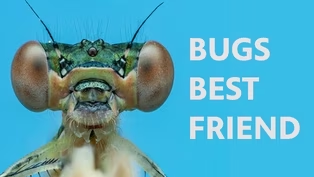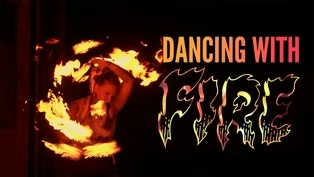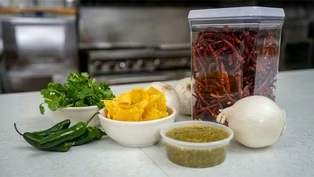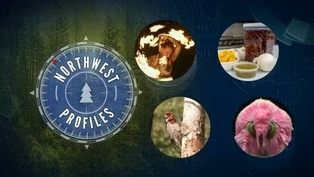Northwest Profiles
October 2025
Season 39 Episode 1 | 26m 2sVideo has Closed Captions
Fire Dancing, Los Cinco Locos Salsa, Insect Photographer, and Birding in the Methow Valley.
Join us for the season premiere of Northwest Profiles! Mesmerizing displays of fire swirl around us as we explore the art of Fire Dancing. A little heat, a lot of heart – meet the woman behind Los Cinco Locos Salsa. Uncover the world of insects though the lens of a brilliant photographer. And, we travel to Winthrop WA, learn about birding, and discover the beauty of the Methow Valley.
Problems playing video? | Closed Captioning Feedback
Problems playing video? | Closed Captioning Feedback
Northwest Profiles is a local public television program presented by KSPS PBS
Funding for Northwest Profiles is provided by Idaho Central Credit Union, with additional funding from the Friends of KSPS.
Northwest Profiles
October 2025
Season 39 Episode 1 | 26m 2sVideo has Closed Captions
Join us for the season premiere of Northwest Profiles! Mesmerizing displays of fire swirl around us as we explore the art of Fire Dancing. A little heat, a lot of heart – meet the woman behind Los Cinco Locos Salsa. Uncover the world of insects though the lens of a brilliant photographer. And, we travel to Winthrop WA, learn about birding, and discover the beauty of the Methow Valley.
Problems playing video? | Closed Captioning Feedback
How to Watch Northwest Profiles
Northwest Profiles is available to stream on pbs.org and the free PBS App, available on iPhone, Apple TV, Android TV, Android smartphones, Amazon Fire TV, Amazon Fire Tablet, Roku, Samsung Smart TV, and Vizio.
Providing Support for PBS.org
Learn Moreabout PBS online sponsorshipGood evening.
Welcome to the premiere of the 39th season of North West Profiles.
Yeah, 39 years here on KSPS PBS.
I'm your host, Tom McArthur.
Have you ever met a fire dancer?
Well, you're about to meet several in our first story tonight.
Fire dancing is an art form as old as human history.
It dazzles and inspires those who have the rare opportunity to see it.
That opportunity is yours right now.
You are about to see a mesmerizing display of fire performed by the people of Burn Works.
Let's see what it takes to spin fire.
Dancing combined with fire is going to be different than anything you have ever experienced.
From sacred rituals to celebrations and storytelling.
Fire and dance have been a part of cultures across the globe since the beginning of human history.
The Fire Dancers at Burn Works in Spokane, Washington, keep this tradition alive through passion and professionalism.
The mission of Burn Works is to bring people together through the love of fire dancing.
From the very, very beginning, a way to teach people what it is, how to do it safely and send them out into the world for the next generation of fire dancers and the community.
I would get together with my friends in parks around town and we would spin fire.
People started to come to us asking, “Hey, can you teach me this?” My friends and I decided, “Hey, why don't we start doing professional classes for people?” Burn Works welcome students with any level of experience.
Instructors provide students with hands on training.
So the one thing that I want people to know when they are taking classes and when I am teaching them, is that safety always comes first.
We teach fire safety course to everybody that comes through our doors.
We want to love the fire.
We want to respect it.
We want everything to be as safe as possible and then exploring our creativity, whether it be in our costume design or our flow arts or how we're maneuvering our implements, we want everything to be very creative and empowering for anybody who comes and does it with us.
Fire dancing has really helped me see myself with more confidence.
When I'm spinning fire, I'm not thinking about anything else.
I'm completely in my body.
It's really helped me see myself in a different way, like really in my femininity and my power.
I can do hard things.
Fire dancing gives performers a chance to connect with the community and introduce audiences to a new art form.
Hey guys, we are doing a fire show, so if you want to gather round, please make sure you just stay behind the yellow tape.
As our performers are working with fire.
How am I feeling right now?
I'm feeling pumped.
I'm super excited.
I love the space and it's nice and clear and open for us.
I love it, I'm just obsessed with it.
It's kind of hard to describe how much it's a part of my life because I'm going to festivals, I'm going to shows.
I'm running a business now.
And it all started from somebody sharing their love of fire spinning with me.
I was going through like this very rugged time in my life.
I didn't really have a direction in which I wanted to go.
Then I saw some fire spinners, but I always thought it was unapproachable.
So as soon as I knew that there were people who actually taught this art and I could get into that, that blew my mind.
I love the community.
I look forward to seeing them.
I just have a sense of belonging because we're all, you know, have the same passion and expressing ourselves.
Weren't surprises.
People, when they try it for the first time is how hot it is.
Honestly.
Why I love teaching fire dancing is I love to share my passion.
I love to get to meet people and participate in the community, be part of building community.
It's very important.
When we get people together and we're having a jam and we're all flowing together.
It just makes me feel like I'm right where I want to be.
It's kind of like being a musician in a way where you can learn things, but you never stop learning.
You always keep going.
It's kind of like soul energy.
You just get this implement and you light it on fire and it ignites your entire life.
There is a safe way to dance with fire.
Terry and her team work closely with the Spokane Fire Department to ensure a safe and fun time for everyone.
Burn works encourages people of all skill levels to join a fire spinning class.
To learn more, visit the website, burnworksfiredancing.com.
Well, what do you think about bugs?
You know, insects.
Not your favorite thing.
I get it.
Maybe that's because you haven't been looking at insects through the best lens.
Dara Ojo is a macro photographer who takes amazing photos of bugs.
Daryl lives up in Edmonton, Alberta, where he's known as a conservation storyteller who uses photography to make you feel empathy for bugs.
The more professional I get, the more picky I get with what I shoot.
I can go out pretty much in one day and not find anything that satisfy me, you know?
It's not like there are no arthropods out there, but I've taken something like this before.
What makes you different?
You know, it has to be maybe they are mating or a Wolf Spider carying babies on her back.
Something that makes it's more spectacular than what I already have.
So I get really picky now.
There you go.
Perfect.
Good pose.
My name is Dara Ojo.
I'm a macro photographer and conservation storyteller.
Macro photography is taking photos of small things and making them look big.
From insects to flowers to even currency, coin to snowflakes.
Anything that is tiny and just making it become magnified.
About five years ago, while I was living in China during the Covid 19 pandemic, I stumbled upon photography.
I was trying to find something positive to do.
So I started taking photos of birds.
And, a friend was like, have you tried looking for insects in China?
And it was very difficult trying to chase a dragonfly and these guys have like multiple lenses on the eye so they can see you coming from afar.
So it was quite frustrating.
But that's how I started macro.
As opposed to using the general language that every layman use insect.
So to be able to group everything together, we call them arthropods.
So arthropods are different classes of creepy crawlers, but I don't want to call them creepy crawlers.
Cute crawlers.
So from your scorpions, to your spiders, to your millipedes to your moth, your butterfly.
They are all classified as arthropods.
I need a spider, come on.
Insects and bugs and arthropods are at the bottom of the food chain.
So it's just like the foundation of a house.
So they are really important to all the ecosystem together.
So if there's a collapse, it has a ripple effect and every other thing collapses.
So they help us with pollination.
You know, apart from bees like everybody think, Wasp also pollinate.
Any insect that fly essentially can pollinate because pollination is just transferring pollen from one flower to the other.
One out of every three bites of food that we eat is contributed by insect.
So that means they are, part of our food security and food chain.
Secondly, they help us as indicators of water.
Just like you can see the woodland behind me.
If there are no dragonflies or damselfly, I know that there's something wrong with that water.
So every every insect has a part to play.
Therre you go buddy, thank you very much.
I don't do much post-production because I'm lazy like that.
Most of the photos you see are straight from my lens.
A bit of touch up here and there, which is just improving the color.
But when it comes to background, I actually carry physical color cards because I use artificial light flash.
If you do not add a bit of color, you're going to end up with black photos, black backgrounds.
As soon as I get my subject, cut off a bit of the branch, I put it on a clamp and I have the background card behind it, and that just gives me that sweet background that I'm looking for.
And most times the the subject always inspires the background.
So if I see that, okay, this is yellow, I think a blue would pop it up.
And that's essentially what makes it beautiful.
That background just takes it to the next level.
And the details that you see is, photo stacking.
because you get so close, you lose your depth of field.
And, to get all those sweet details, you need to focus stack, you know, taking photos from different depth of field from the closest spot of the camera all the way to the back.
I do post-production in Helicon Focus.
It stitches the photo together for you, and, it gives you a final output.
And that is thrown back into Lightroom where you can just, you know, improve the colors and sharpen the photo.
And that's it.
In 2022, I was just scrolling on Instagram and, I got a message pop up in my inbox that was one of the producers.
He would love to talk to me.
He called me out from New York that day, and he told me about the project that he was shooting.
Bugs from different part of the world.
And, he felt that my story was going to be perfect because I have zero background in sciences.
I'm in town, guys.
Come out.
What!
Thats so rude.
Turning a lens on this miniature world is how one man hopes to bring focus to the planet's unnoticed heroes.
You know, for me to be so interested in this.
And because most part of the show has to do with people with science entimology backgrounds.
I wouldnt say I have zero knowledge.
But I have no credentials in sciences.
I've, spoken to a lot of entomologists, and we've rubbed minds together.
I've taken up a course, Bug 101 at the University of Alberta.
So bringing in that perspective of someone that, you know, shows the beauty so you can develop empathy.
And when you pull people in with empathy, you're able to preach the conservation story to them.
So it was like, that's perfect.
You know, people, people can get bored of all the science lingo then now there's a bit of, art approach to.
I bridge Art, science and conservation through storytelling with my photos.
So beautiful.
Which is art, that pulls people in.
And I use science fact to preach the conservation story to people.
Then after people have listened.
Then you also use science practice to tell them, okay, this is what you can do.
Grow more wild flowers.
For example.
Stop squashing bugs.
That is the step art, science, conservation.
They'll work hand in hand.
Stay beautiful.
So I've seen a lot of comments from people saying that they view bugs differently now that they see my photo that comes to mind first when they see any arthropod and people are like, oh, well, I saw your photo.
And when next I saw an insect in my house, a spider I just gently took it out.
My first instinct was to kill it.
But then I remember your photo, and I just kind of changes my mind and that that's all I want to hear, because that kind of shows that I'm doing something right.
My last message to everybody is like, you know, that insect that crawl in six legged or four legged, creature in your house, or that you see in your classroom or on your path to work, just let it go.
Just let it be.
It has it has a purpose to serve.
You can check out Dara's website for more amazing photos of bugs.
Or follow him on Instagram to see what he's captured lately.
You know what salsa is?
Yes.
Have you tasted salsa made by the five crazy ones?
What started as a taste of home has become a local favorite.
Meet the woman behind Los Cinco Loco Salsa.
Shes been my salsa dealer for at least...two years!
In the small town of Deer Park, Washington a taste of El Paso, Texas has taken root.
For Rebecca Honshiko, salsa isnt just a condiment.
[Rebecca: All right.
What did we decide on?]
It's a connection to home family, and community.
[Rebecca] My son, he thought pepper was spicy.
And now he eats it like his father, so.
They eat it like cereal.
I can't even keep it like in my household.
And when I run out, it's, it's bad.
Rebecca moved from El Paso in 2007.
Missing the flavors of home, she reached out to her aunt for the family salsa recipe.
At first, she made it for friends and family, but before long, word spread and Los Cinco Locos Salsa was born.
[Rebecca] I first started off at the Deer Park Market, and I'm still there currently.
That was about maybe four years ago.
I have people coming from all over and they'll buy like six, eight at a time.
[Customer: Ill do two verde and one red.]
My favorite thing people say is like, I came here just for you, and they'll run in and grab their salsa on the way to their lake, and then they'll take off, [Rebecca: Do you eat all these all or do you pick it up for other people?]
[Customer: No, no, I eat them.]
[Rebecca and daughter laugh] [Rebecca: Theres no shame!
Theres no shame!]
You know, or I'm picking up for my whole office, you know, those kind of things.
I always just get a kick out of that.
So that makes me happy.
Starting a food business wasn't easy.
Finding a commercial kitchen was a challenge until the local Eagles Club opened their doors.
Their motto is “people helping people”.
And they have, they have helped me.
I wouldn't have been able to start without them.
From there, production became a true family effort.
[Rebecca] The whole family's in the production.
Whether it's my kids coming to help me.
My husband does a lot of the packing.
So it is a family production from start to finish.
But behind every jar is a long day's work.
Roasting, blending, packaging and always keeping flavors consistent.
When I first started, I just kind of threw things in a food processor and hoped for the best and didn't measure anything actually.
Even when I asked my aunt for the recipe, she was like, I don't know how much, you know, she didn't know any measurements because we didn't measure anything.
And so when I was doing it as a business, I was like, all right, I got to get some measurements for consistency.
[Rebecca: All of thats in there and then Ill just measure my salt.]
But sometimes the ingredients might be more potent than others so like my ingredients like for cilantro.
If I don't get good stuff, it'll make or break, like, my batch.
It's not bad, but when I have good cilantro?
It's definitely like a lot better.
Her signature comes from Chile de arbol, a pepper with heat that builds slowly, creating flavor without overpowering.
It's not a knock your socks off heat.
It's an enjoyable heat.
The name Los Cinco Locos ...the five crazies... started as a family joke.
But now it's part of the brand's identity.
When I was doing it for friends, I'm like, oh, we have five people, and we're all kind of crazy in our own way.
And so I just did it as a joke.
Actually when people come see me, they're like, well, which one are you?
Which crazy one are you?
Or if the kids are there, I'm like, oh, that's number 5 or whatever.
So, yeah, it was kind of funny to start off with.
Rebecca doesn't have a strict business plan.
For her, the joy comes from connecting with her community and letting the salsa speak for itself.
Where I see it in maybe a year, five years.
Honestly, I dont really have too much of a plan, which is kind of a bad business plan, but I've always just kind of let it be what it is.
And if grows into something, it grows into something.
If I just do this, I'm okay with that because I enjoy what I do now.
Rebecca Hanshiko proves that sometimes the simplest ingredients, family, tradition and a little heat make the best recipe.
Nothing crazy about that.
Here's an idea for seniors searching for something that gets them up and out of their recliners.
Follow along with us to the Metal Valley near Winthrop, Washington, as we meet up with a group from Methow At Home as they explore the world of birding.
I'm Pat Leigh and I live in the Methow Valley and love it.
I enjoy bird photography, and today we're out here to do a little bird walk around a very popular birding area called Beaver Pond up near the Sun Mountain Lodge.
Does everyone know what a cedar wax wing looks like?
This is a cedar wax wing.
Oh, theres an app it's called Merlin bird I.D.. And just, a few minutes ago, I recorded the birds in this area.
it Ided a varied thrush.
Of course, we have robins.
We have red wing black birds.
the Western tanager, a yellow warbler, a Cassions finch.
And suddenly you just realize, oh, my goodness, there are so many things to watch for.
Yeah.
So I love it.
so we've already heard a lot of birds in this area, but let's start watching.
And also if you see movement, like right now, I see a redwing blackbird flying out over the grasses there.
So.
Okay.
Shall we start walking?
I'm introducing some folks who are members of Methow at home, an organization intended to help people age in place, I'm introducing people to, a way of birding by sounds.
He looks kind of blue.
He's pretty.
It picked one of those up when I was in the parking lot.
The Methow Valley is, is a Mecca for birds.
You have so much great habitat and such varied habitat, everything from pine forests to quaking aspen to rivers, lakes, streams.
It's everything a bird might be looking for.
That's a Swainson's thrush.
“mimics sound” we're getting into a stretch where we see a lot of woodpeckers were hoping we're going to get.
Possibly a Lewis woodpecker today.
Does everyone see the baby swallows ahead of me.
Right here is this three perched right there.
Is that the Western woods And I think I just heard the Western Kingbird.
One of my favorite things about bird photography is when.
When they're feeding their young.
If you capture multiple images of them bringing in food to the nest, there's a variety of bugs they can find in your yard is pretty remarkable.
Oh, there goes our middle Harrier.
Oh, wow.
Ooh!
Wow, that was exciting to see the Male Harrier.
It's.
It's a rare thing, and they fly, so fast.
Just over here.
I think we have flickers, nests.
Anyone find the flickers nest?
Oh.
There's some other couple.
Do you hear that sound?
That's that's that's Virginia rail.
We're hearing some.
Oh, yeah.
Did you pick it up?
Good job.
Wow.
It's strange looking.
Yes.
I'd love to see that bird.
I like that one.
Here she is with her head poking out of the nest.
And then, Here she is in flight.
Cool.
So I like the one peeking out.
Yeah.
Yeah.
It was.
Yeah.
Orange on.
Yeah.
Nice.
They're amazing birds.
And this is the northern flicker, right?
with birding, you can do it anywhere.
You can do it in your backyard.
You can take a walk.
You can climb a mountain birding is something you do wherever you are.
Once you get hooked.
It's surprising and amazing how much ground the group covered in the morning of birding.
What a wonderful way to learn about birds and get some exercise on the trail to boot.
Thank you for joining us on this, the 39th season premiere of Northwest Profiles.
Yeah, 39 years for this award winning feature program that highlights the people, places, and events that make the Inland Northwest unique.
Some of our best story ideas come from people like you.
If you've got a story idea to share, tell us about it online at ksps.org.
I'm Tom McArthur.
Thank you for including Northwest Profiles in your evening.
See you again in November and bye for now.
Video has Closed Captions
Clip: S39 Ep1 | 7m 40s | We follow along with a birding group that gives Seniors an introduction to Birding with sound. (7m 40s)
Video has Closed Captions
Clip: S39 Ep1 | 7m 47s | Photographer Dara Ojo shares how a pandemic hobby turned into a passion seen around the world! (7m 47s)
Video has Closed Captions
Clip: S39 Ep1 | 5m 22s | In Spokane, Washington, a small troupe of fire dancers is lighting up the community — literally. (5m 22s)
Video has Closed Captions
Clip: S39 Ep1 | 4m 15s | Los Cinco Locos Salsa: How a Family Recipe from El Paso Became a Washington Favorite! (4m 15s)
Video has Closed Captions
Preview: S39 Ep1 | 30s | Fire Dancing, Los Cinco Locos Salsa, Insect Photographer, and Birding. (30s)
Providing Support for PBS.org
Learn Moreabout PBS online sponsorshipSupport for PBS provided by:
Northwest Profiles is a local public television program presented by KSPS PBS
Funding for Northwest Profiles is provided by Idaho Central Credit Union, with additional funding from the Friends of KSPS.

